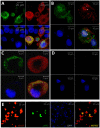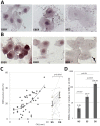EBV infection is common in gingival epithelial cells of the periodontium and worsens during chronic periodontitis
- PMID: 24367478
- PMCID: PMC3868609
- DOI: 10.1371/journal.pone.0080336
EBV infection is common in gingival epithelial cells of the periodontium and worsens during chronic periodontitis
Abstract
An amplifying role for oral epithelial cells (ECs) in Epstein-Barr Virus (EBV) infection has been postulated to explain oral viral shedding. However, while lytic or latent EBV infections of oro/nasopharyngeal ECs are commonly detected under pathological conditions, detection of EBV-infected ECs in healthy conditions is very rare. In this study, a simple non-surgical tissue sampling procedure was used to investigate EBV infection in the periodontal epithelium that surrounds and attaches teeth to the gingiva. Surprisingly, we observed that the gingival ECs of the periodontium (pECs) are commonly infected with EBV and may serve as an important oral reservoir of latently EBV-infected cells. We also found that the basal level of epithelial EBV-infection is significantly increased in chronic periodontitis, a common inflammatory disease that undermines the integrity of tooth-supporting tissues. Moreover, the level of EBV infection was found to correlate with disease severity. In inflamed tissues, EBV-infected pECs appear to be prone to apoptosis and to produce larger amounts of CCL20, a pivotal inflammatory chemokine that controls tissue infiltration by immune cells. Our discovery that the periodontal epithelium is a major site of latent EBV infection sheds a new light on EBV persistence in healthy carriers and on the role of this ubiquitous virus in periodontitis. Moreover, the identification of this easily accessible site of latent infection may encourage new approaches to investigate and monitor other EBV-associated disorders.
Conflict of interest statement
Figures






Similar articles
-
Unveiling the Etiopathogenic Role of Epstein-Barr Virus in Periodontitis.J Dent Res. 2025 Apr;104(4):449-458. doi: 10.1177/00220345241303138. Epub 2025 Jan 28. J Dent Res. 2025. PMID: 39876607 Free PMC article.
-
How Does Epstein-Barr Virus Contribute to Chronic Periodontitis?Int J Mol Sci. 2020 Mar 12;21(6):1940. doi: 10.3390/ijms21061940. Int J Mol Sci. 2020. PMID: 32178406 Free PMC article. Review.
-
Higher prevalence of Epstein-Barr virus DNA in deeper periodontal pockets of chronic periodontitis in Japanese patients.PLoS One. 2013 Aug 26;8(8):e71990. doi: 10.1371/journal.pone.0071990. eCollection 2013. PLoS One. 2013. PMID: 23991022 Free PMC article.
-
Real-time polymerase chain reaction quantification of human cytomegalovirus and Epstein-Barr virus in periodontal pockets and the adjacent gingiva of periodontitis lesions.J Periodontal Res. 2005 Apr;40(2):97-104. doi: 10.1111/j.1600-0765.2005.00770.x. J Periodontal Res. 2005. PMID: 15733143
-
EBV Infection and Glucose Metabolism in Nasopharyngeal Carcinoma.Adv Exp Med Biol. 2017;1018:75-90. doi: 10.1007/978-981-10-5765-6_6. Adv Exp Med Biol. 2017. PMID: 29052133 Review.
Cited by
-
Chemokine function in periodontal disease and oral cavity cancer.Front Immunol. 2015 May 5;6:214. doi: 10.3389/fimmu.2015.00214. eCollection 2015. Front Immunol. 2015. PMID: 25999952 Free PMC article. Review.
-
Detection of Epstein-Barr virus infection in primary junctional epithelial cell cultures.J Oral Microbiol. 2024 Jan 3;16(1):2301199. doi: 10.1080/20002297.2023.2301199. eCollection 2024. J Oral Microbiol. 2024. PMID: 38188074 Free PMC article.
-
Prevalence of herpesviruses in periodontal disease of the North Indian population: A pilot study.J Indian Soc Periodontol. 2020 Mar-Apr;24(2):163-166. doi: 10.4103/jisp.jisp_62_19. Epub 2020 Mar 2. J Indian Soc Periodontol. 2020. PMID: 32189845 Free PMC article.
-
Association between Epstein-Barr virus and periodontitis: A meta-analysis.PLoS One. 2021 Oct 7;16(10):e0258109. doi: 10.1371/journal.pone.0258109. eCollection 2021. PLoS One. 2021. PMID: 34618843 Free PMC article.
-
The BDLF3 gene product of Epstein-Barr virus, gp150, mediates non-productive binding to heparan sulfate on epithelial cells and only the binding domain of CD21 is required for infection.Virology. 2016 Jul;494:23-8. doi: 10.1016/j.virol.2016.04.002. Epub 2016 Apr 8. Virology. 2016. PMID: 27061054 Free PMC article.
References
Publication types
MeSH terms
LinkOut - more resources
Full Text Sources
Other Literature Sources

